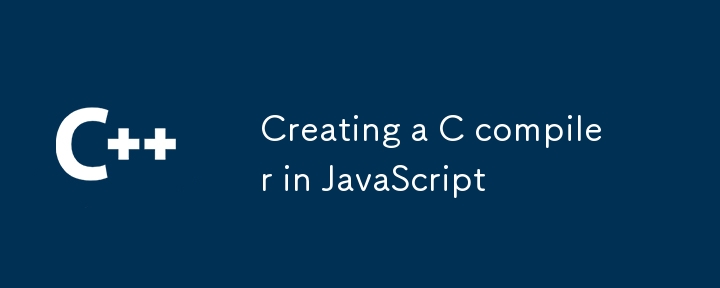

Creating a C compiler in JavaScript is a complex and ambitious project that involves several components, including lexical analysis, parsing, semantic analysis, and code generation. Below is a simplified and high-level example of how you might start building such a compiler. This example will focus on the lexical analysis (tokenization) and parsing stages, which are the first steps in compiling C code.
The lexical analyzer (lexer) converts the input C code into a stream of tokens.
class Lexer {
constructor(input) {
this.input = input;
this.tokens = [];
this.current = 0;
}
tokenize() {
while (this.current < this.input.length) {
let char = this.input[this.current];
if (/\s/.test(char)) {
this.current++;
continue;
}
if (/[a-zA-Z_]/.test(char)) {
let start = this.current;
while (/[a-zA-Z0-9_]/.test(this.input[this.current])) {
this.current++;
}
this.tokens.push({ type: 'IDENTIFIER', value: this.input.slice(start, this.current) });
continue;
}
if (/[0-9]/.test(char)) {
let start = this.current;
while (/[0-9]/.test(this.input[this.current])) {
this.current++;
}
this.tokens.push({ type: 'NUMBER', value: this.input.slice(start, this.current) });
continue;
}
switch (char) {
case '+':
this.tokens.push({ type: 'PLUS', value: '+' });
this.current++;
break;
case '-':
this.tokens.push({ type: 'MINUS', value: '-' });
this.current++;
break;
case '*':
this.tokens.push({ type: 'STAR', value: '*' });
this.current++;
break;
case '/':
this.tokens.push({ type: 'SLASH', value: '/' });
this.current++;
break;
case '=':
this.tokens.push({ type: 'EQUAL', value: '=' });
this.current++;
break;
case ';':
this.tokens.push({ type: 'SEMICOLON', value: ';' });
this.current++;
break;
case '(':
this.tokens.push({ type: 'LPAREN', value: '(' });
this.current++;
break;
case ')':
this.tokens.push({ type: 'RPAREN', value: ')' });
this.current++;
break;
default:
throw new TypeError('Unexpected character: ' + char);
}
}
return this.tokens;
}
}
The parser converts the stream of tokens into an abstract syntax tree (AST).
class Parser {
constructor(tokens) {
this.tokens = tokens;
this.current = 0;
}
parse() {
let ast = {
type: 'Program',
body: []
};
while (this.current < this.tokens.length) {
ast.body.push(this.parseStatement());
}
return ast;
}
parseStatement() {
let token = this.tokens[this.current];
if (token.type === 'IDENTIFIER' && this.tokens[this.current + 1].type === 'EQUAL') {
return this.parseAssignment();
}
throw new TypeError('Unknown statement: ' + token.type);
}
parseAssignment() {
let identifier = this.tokens[this.current];
this.current++; // skip identifier
this.current++; // skip equal sign
let value = this.parseExpression();
this.expect('SEMICOLON');
return {
type: 'Assignment',
identifier: identifier.value,
value: value
};
}
parseExpression() {
let token = this.tokens[this.current];
if (token.type === 'NUMBER') {
this.current++;
return {
type: 'Literal',
value: Number(token.value)
};
}
throw new TypeError('Unknown expression: ' + token.type);
}
expect(type) {
let token = this.tokens[this.current];
if (token.type !== type) {
throw new TypeError('Expected ' + type + ' but found ' + token.type);
}
this.current++;
}
}
Finally, the code generator converts the AST into the target language, which could be JavaScript or any other language.
class CodeGenerator {
generate(node) {
switch (node.type) {
case 'Program':
return node.body.map(statement => this.generate(statement)).join('\n');
case 'Assignment':
return `let ${node.identifier} = ${this.generate(node.value)};`;
case 'Literal':
return node.value;
default:
throw new TypeError('Unknown node type: ' + node.type);
}
}
}
Here is how you might use the lexer, parser, and code generator:
const input = `x = 42;`;
const lexer = new Lexer(input);
const tokens = lexer.tokenize();
console.log('Tokens:', tokens);
const parser = new Parser(tokens);
const ast = parser.parse();
console.log('AST:', JSON.stringify(ast, null, 2));
const generator = new CodeGenerator();
const output = generator.generate(ast);
console.log('Output:', output);
This will tokenize the input, parse it into an AST, and generate JavaScript code from the AST.
This example is highly simplified and only handles a tiny subset of the C language. A full-fledged C compiler would require handling a much larger set of tokens, parsing complex expressions, statements, declarations, types, and generating more sophisticated code.
The above is the detailed content of Creating a C compiler in JavaScript. For more information, please follow other related articles on the PHP Chinese website!
 How to use DataReader
How to use DataReader
 Solution to split word table into two pages
Solution to split word table into two pages
 Introduction to screenshot shortcut keys in win8
Introduction to screenshot shortcut keys in win8
 What to do if there is no cursor when clicking on the input box
What to do if there is no cursor when clicking on the input box
 Introduction to the usage of rowid in oracle
Introduction to the usage of rowid in oracle
 Detailed explanation of nginx configuration
Detailed explanation of nginx configuration
 How to solve securecrt garbled code
How to solve securecrt garbled code
 Why can swoole be resident in memory?
Why can swoole be resident in memory?




